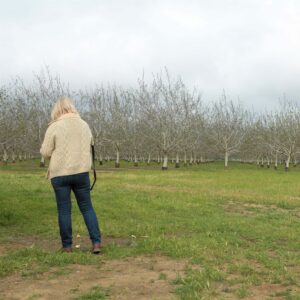During the spring and summer months, Yolo Land Trust staff travel across Yolo County to conduct annual monitoring of our 12,240+ acres of conserved farmland.
Yolo Land Trust holds 72 agricultural conservation easements across Yolo County. A conservation easement is a voluntary tool that allows landowners to conserve their land while retaining ownership. It is a legal restriction that a landowner places on his or her property to define and limit the type of development that may take place there. Generally, conservation easements are either donated or sold to nonprofit conservation organizations like Yolo Land Trust which then carry the responsibility to enforce the restrictions in perpetuity.
Liz Heckles, Land Stewardship Director at Yolo Land Trust, is responsible for visiting all of Yolo Land Trust’s conservation easement farms annually. Recently, Liz sat down to answer a few questions about monitoring, and as a valued supporter we want to give you the inside scoop on the great work she is doing in the field.
What is monitoring and why is it important?
Monitoring is one facet of stewardship that allows both the landowner and the easement holder (YLT) an opportunity to confirm that the tenets of the Conservation Easement Agreement are being upheld. It serves as an assurance that over time, as farming practices and agricultural uses evolve, that the easement’s purpose, which is generally to continue to farm, is maintained.
What are you doing when monitoring? What are you looking for?
I’m always referring to the terms of the individual easement and the state of the property that was documented when the easement was established and looking for changes to the landscape and structural development.
How often do you monitor YLT conservation easements?
YLT has a responsibility to monitor each of our easements every year – that means visits to 72 farms in Yolo County this year. Occasionally there is an event or circumstance (a new landowner, construction on site, a county or city public works project nearby) that prompts additional visits.
How long does it take to monitor one farm? All farms?
Monitoring visits vary from farm to farm based on acreage and complexity of the easement. Some easement properties can be assessed in an hour, others may require a few hours or a day to get around and really inspect.
Visiting all 72 farm easements and making sure to record and document everything that’s going on for the year usually stretches from late spring through the summer, coinciding with peak production times for most of the agricultural commodities grown in Yolo County.
What do you enjoy most about monitoring?
I love checking in on all our easement properties and seeing the variety in commodities, the diversity in farming techniques and the continuity year after year of food production. Farming is such a vital part of Yolo County, and something that is increasingly more unique in this region, and I hope our work at YLT allows it to continue and thrive.
I’m looking forward to meeting face-to-face with the owners. I invite every owner to show me their farm and I hope more will be able to do that this year. I want to personally thank each one for their commitment to keep farming in Yolo County.
What are the biggest challenges faced when monitoring?
One of my personal goals in monitoring is to tread lightly and create the least disruption while I’m out visiting. I’m really trying to make sure I’m not getting in the way of any farming activities that might be going on while I’m out surveying.

Follow along on Facebook and Instagram for a look into our future monitoring visits!
Visit ‘Our Lands‘ for more information on our agricultural conservation easements.

